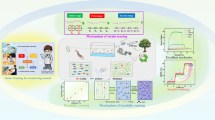Abstract
Negative Differential Resistance (NDR) was studied in details on the MEH-PPV decorated electrospun TiO2 mat. The TiO2 nanofibrous mat was fabricated by the electrospinning method and the as-fabricated mat was decorated with MEH-PPV through simple chemical bath deposition method. The peak-to-valley ratio of the NDR was 1.85. The observed phenomenon was light dependent, i.e., under light that NDR disappeared completely. We have examined that though in the wavelength region of 650–675 nm the NDR could sustain, for other wavelengths in the visible spectrum, it has been ceased to exist. The NDR behavior was steady and stable over several cycles.





Similar content being viewed by others
References
G. Liu, S. Ahsan, A.G. Khitun et al., Graphene-based non-Boolean logic circuits. J. Appl. Phys. 114(15), 154310 (2013)
K.-J. Gan, C.-S. Tsai, Y.-W. Chen et al., Voltage-controlled multiple-valued logic design using negative differential resistance devices. Solid State Electron. 54(12), 1637–1640 (2010)
S. Kumar, Z. Wang, N. Davila et al., Physical origins of current and temperature controlled negative differential resistances in NbO2”. Nat. Commun. 8(1), 658 (2017)
J.-Y. Cheng, B.L. Fisher, N.P. Guisinger et al., Atomically manufactured nickel–silicon quantum dots displaying robust resonant tunneling and negative differential resistance. npj Quant. Mater. 2(1), 25 (2017)
X. Liu, M.T. Mayer, D. Wang, Negative differential resistance and resistive switching behaviors in Cu2S nanowire devices. Appl. Phys. Lett. 96(22), 223103 (2010)
C. Guo, C. Xia, T. Wang et al., Carbon-doping-induced negative differential resistance in armchair phosphorene nanoribbons. J. Semicond. 38(3), 033005 (2017)
S. Chang, L. Zhao, Y. Lv et al., Negative differential resistance in graphene nanoribbon superlattice field-effect transistors. IET Micro Nano Lett. 10(8), 400–403 (2015)
W. Pfaff, B.J. Hensen, H. Bernien et al., Unconditional quantum teleportation between distant solid-state quantum bits. Science 345(6196), 532–535 (2014)
P. Chakraborty, S. Pillet, E.-E. Bendeif et al., Light-induced bistability in the 2 D coordination network {[Fe(bbtr)3][BF4]2}∞: wavelength-selective addressing of molecular spin states. Chem. A Eur. J. 19(34), 11418–11428 (2013)
H. Xie, M.J. He, X.Y. Deng et al., Design of poly(l-lactide)-poly(ethylene glycol) copolymer with light-induced shape-memory effect triggered by pendant anthracene groups. ACS Appl. Mater. Interfaces 13(8), 9431 (2016)
W.-J. Yoon, S.-Y. Chung, P.R. Berger et al., Room-temperature negative differential resistance in polymer tunnel diodes using a thin oxide layer and demonstration of threshold logic. Appl. Phys. Lett. 87(20), 203506 (2005)
K.W. Lee, C.W. Jang, D.H. Shin et al., Light-induced negative differential resistance in graphene/Si-quantum-dot tunneling diodes. Sci. Rep. 6, 30669 (2016)
I.-W. Lyo, P. Avouris, Negative Differential resistance on the atomic scale: implications for atomic scale devices. Science 245(4924), 1369–1371 (1989)
A.M. Eppler, I.M. Ballard, J. Nelson, Charge transport in porous nanocrystalline titanium dioxide. Phys. E 14(1–2), 197–202 (2002)
C. Dette, M.A. Pérez-Osorio, C.S. Kley et al., TiO2 anatase with a bandgap in the visible region. Nano Lett. 14(11), 6533–6538 (2014)
H.-W. Chen, T.-Y. Huang, T.-H. Chang et al., Efficiency enhancement of hybrid perovskite solar cells with MEH-PPV hole-transporting layers. Sci. Rep. 6, 34319 (2016)
J. Nowotny, Titanium dioxide-based semiconductors for solar-driven environmentally friendly applications: impact of point defects on performance. Energy Environ. Sci. 1(5), 565–572 (2008)
Acknowledgements
This work was supported by SERB (DST) (Grant no. ECR/2015/000208). K.M. is thankful to SERB (SB/FTP/PS-167/2013) and BRNS (34/14/26/2014-BRNS/1749) for financial support.
Author information
Authors and Affiliations
Corresponding authors
Electronic supplementary material
Below is the link to the electronic supplementary material.
Rights and permissions
About this article
Cite this article
Mohanta, K., Karthega, M. & Batabyal, S.K. Light-dependent negative differential resistance in MEH-PPV decorated electrospun TiO2 mat. Appl. Phys. A 124, 349 (2018). https://doi.org/10.1007/s00339-018-1758-3
Received:
Accepted:
Published:
DOI: https://doi.org/10.1007/s00339-018-1758-3




